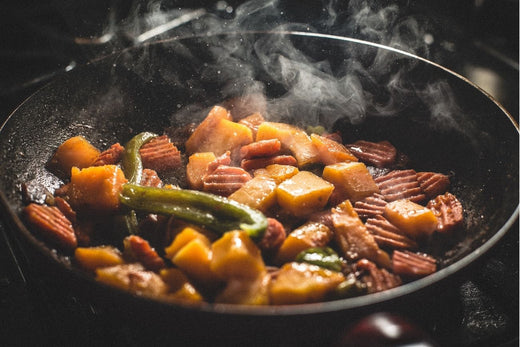
5 Grammar Rules for Beginner Cooks Learning Spanish
Share
5 Grammar Rules Every Beginner Cook Learning Spanish Should Know
Cooking and learning Spanish have a lot in common: both require patience, practice, and following certain rules. If you're learning Spanish and love the culinary world, understanding basic grammar rules can be just as important as mastering a recipe. In this article, you’ll discover 5 essential Spanish grammar rules, explained in a practical way with examples related to cooking.
1. Correct Use of Articles: Essential Ingredients

In Spanish, articles (el, la, los, las) are like essential ingredients in any recipe: without them, something doesn’t add up. Articles accompany nouns and must agree in gender (masculine or feminine) and number (singular or plural).
- Correct example: El tomate, la cebolla, los ajos, las zanahorias.
- Common mistake: Saying la tomate or el cebolla.
Grammar Tip: If in doubt, remember that words ending in -a are usually feminine (la ensalada), and those ending in -o are usually masculine (el horno).
2. Singular and Plural: Cooking for One or for Many

Just like adjusting a recipe for the number of guests, in Spanish you must change words from singular to plural when necessary. To form the plural, you generally add -s to words ending in a vowel and -es to words ending in a consonant.
- Singular example: el huevo, la cuchara.
- Plural example: los huevos, las cucharas.
- Words ending in a consonant: el mantel → los manteles.
Quick Tip: Practice with shopping lists. If you need "one tomato" for yourself but you're cooking for a family, you'll know to say "five tomatoes" (cinco tomates).
Want to practice these rules while enjoying fun short stories?
Learning Spanish is like cooking: you need to practice each step to get the best results. If you want to improve your grammar while immersing yourself in captivating stories, “Latin American Spanish Short Stories” is the perfect tool for you.
Are you ready to take your Spanish to the next level? Start today with short, practical stories!
3. Adjectives: Seasoning the Noun
In Spanish, adjectives describe the characteristics of nouns, like the flavor or texture of a dish. It’s important that they agree in gender and number with the noun they accompany.
- Correct example: El arroz blanco (white rice), las salsas deliciosas (delicious sauces).
- Incorrect example: El arroz blanca or las salsa delicioso.
Practical Tip: Think of adjectives as the seasonings in a recipe: they must pair perfectly with the main ingredient for everything to turn out delicious.
4. The Verbs Ser and Estar: Two Ingredients, Different Uses

"Ser" and "estar" are two essential verbs in Spanish, but they have different uses. The difference between them is like choosing salt or sugar: one small mistake can change the entire outcome.
- Ser is used for permanent characteristics: El cuchillo es afilado. (The knife is sharp – a characteristic of the knife).
- Estar is used for temporary states or locations: El cuchillo está sucio. (The knife is dirty – a temporary state).
Useful Exercise: Describe the state of your ingredients or utensils: La sopa está caliente. (The soup is hot.) / El plato es redondo. (The plate is round.)
5. Verb Tenses: Cooking in the Past, Present, and Future
In cooking, you need to follow instructions at different moments: what you’ve already done, what you’re doing now, and what you’ll do next. In Spanish, this is expressed with different verb tenses.
- Present: Corto las verduras. (I cut the vegetables).
- Past (preterite): Corté las verduras. (I cut the vegetables).
- Future: Cortaré las verduras. (I will cut the vegetables).
Practical Recipe Example:
- First, lavé los tomates. (I washed the tomatoes – past action).
- Now, corto los tomates. (I cut the tomatoes – present action).
- Later, añadiré sal y aceite. (I will add salt and oil – future action).
Conclusion
Mastering Spanish grammar rules can be as simple as following a recipe: with practice and good examples, your Spanish will become clearer and more natural. Take advantage of any moment in the kitchen to review these rules, and improve even further with books that motivate you to read and learn.
Reinforce Your Spanish with Practical and Fun Stories
Mastering grammar is easier when you learn it in context. If you're ready to combine learning with the pleasure of reading, check out “Latin American Spanish Short Stories”. This book is ideal for cooks and Spanish learners who want to improve fluency naturally and enjoyably.
Are you ready to take your Spanish to the next level? Start today with short, practical stories!
